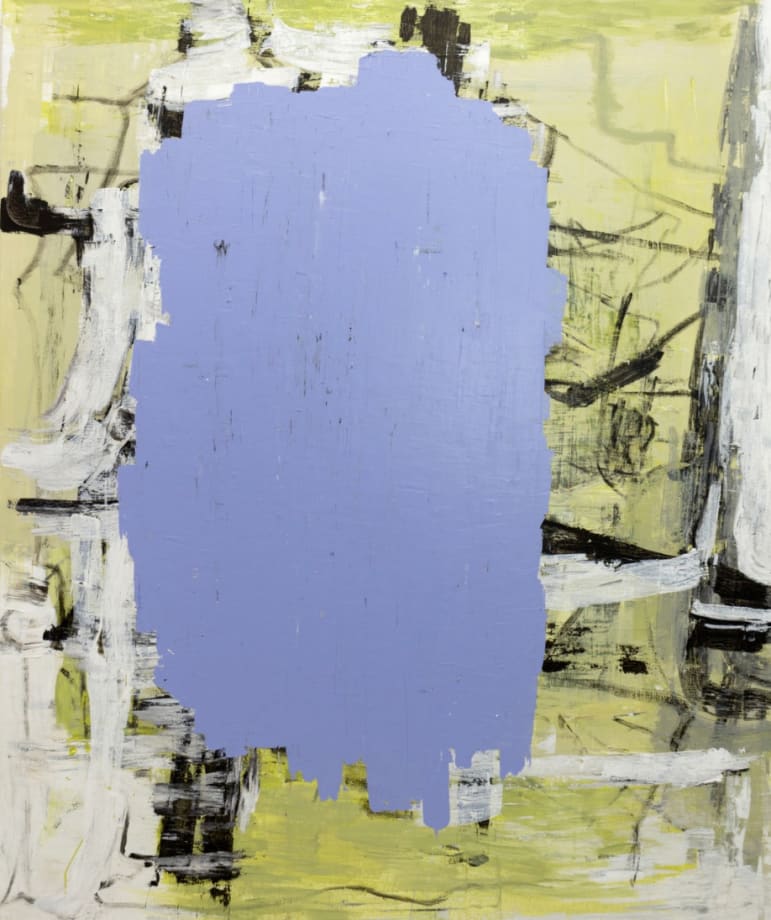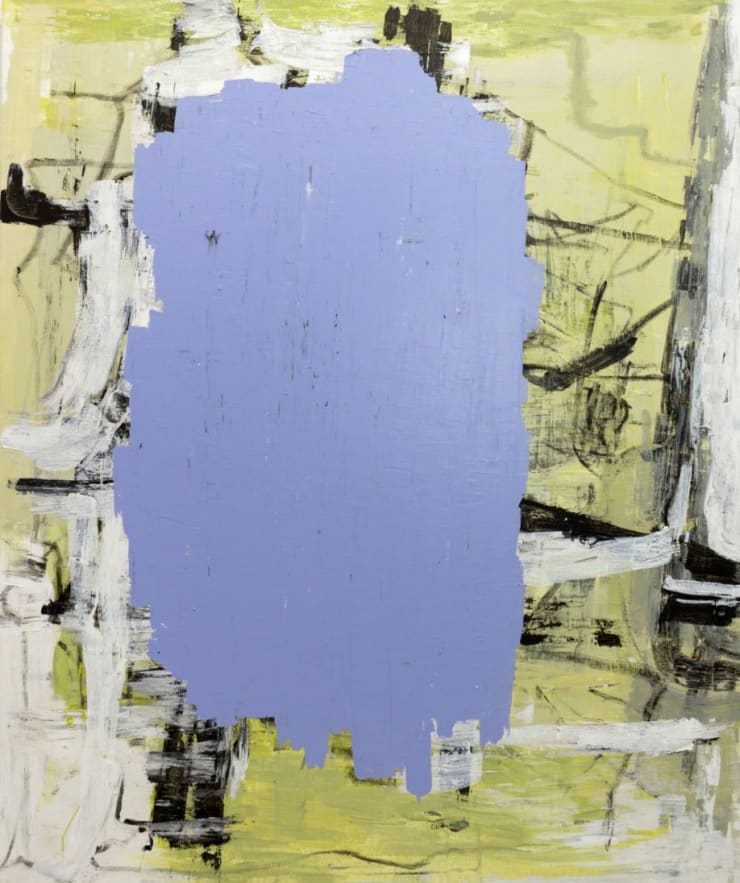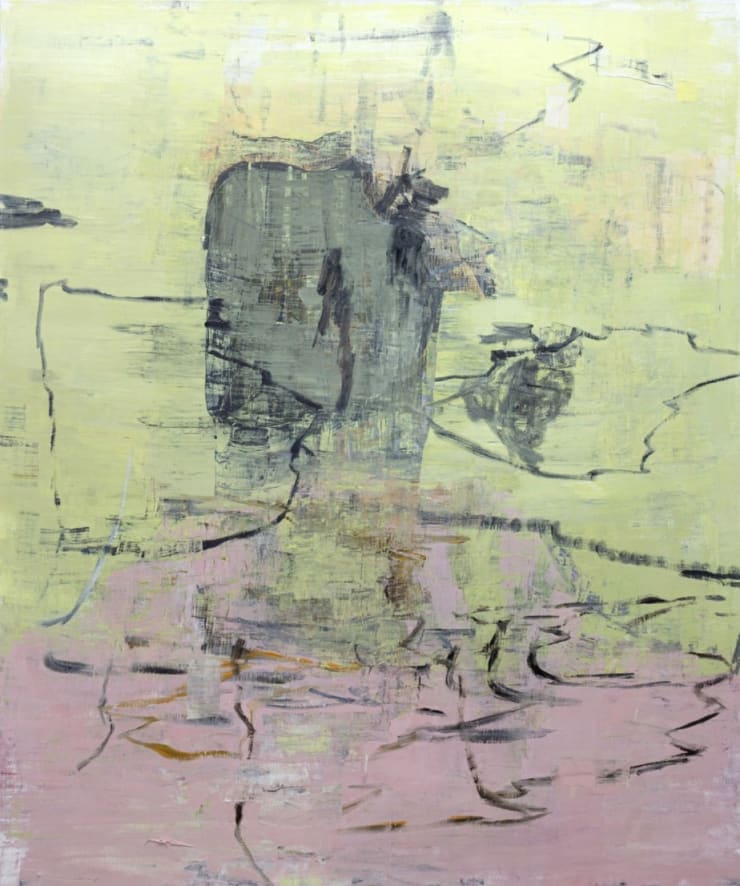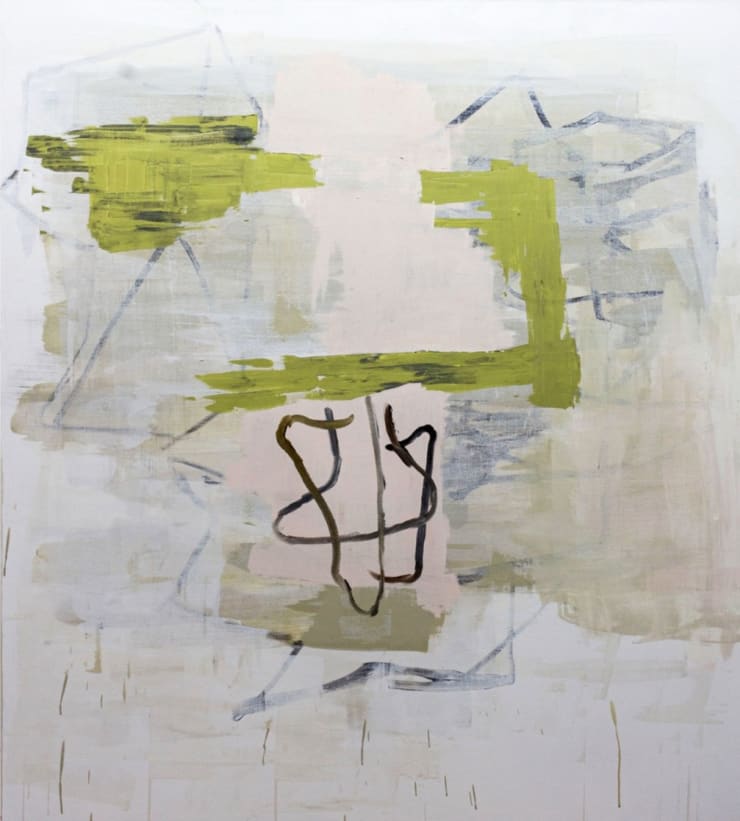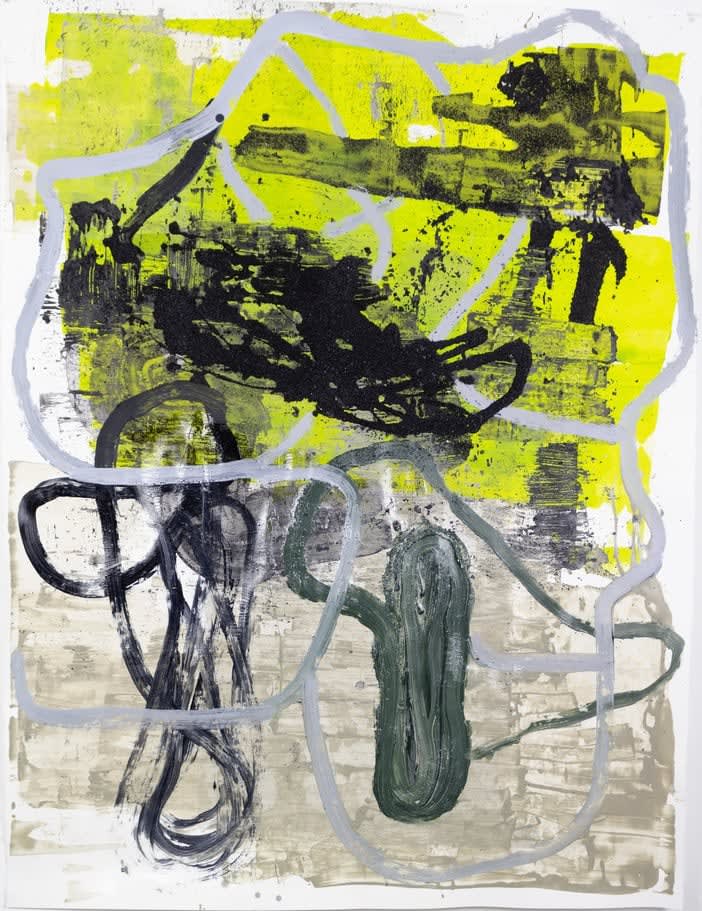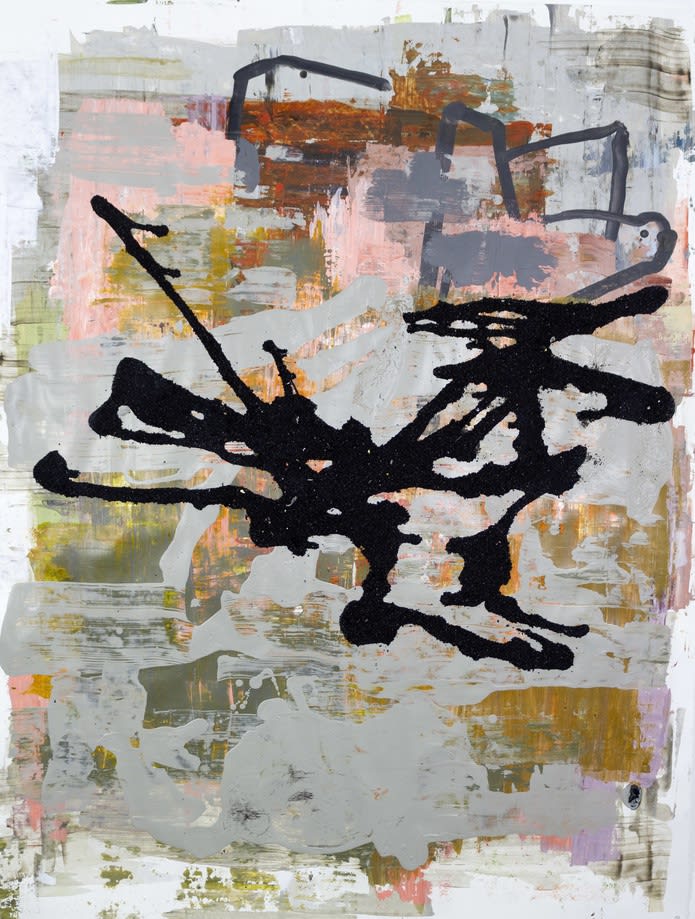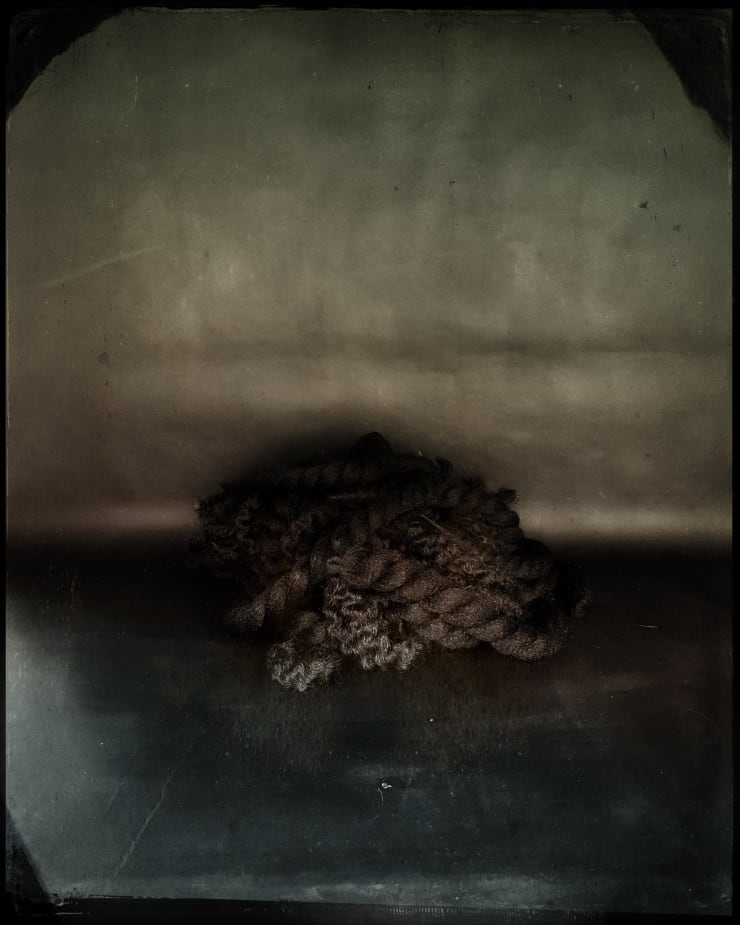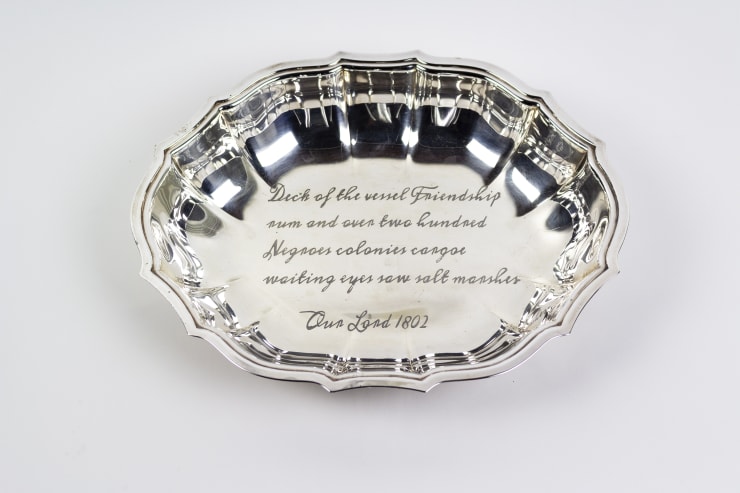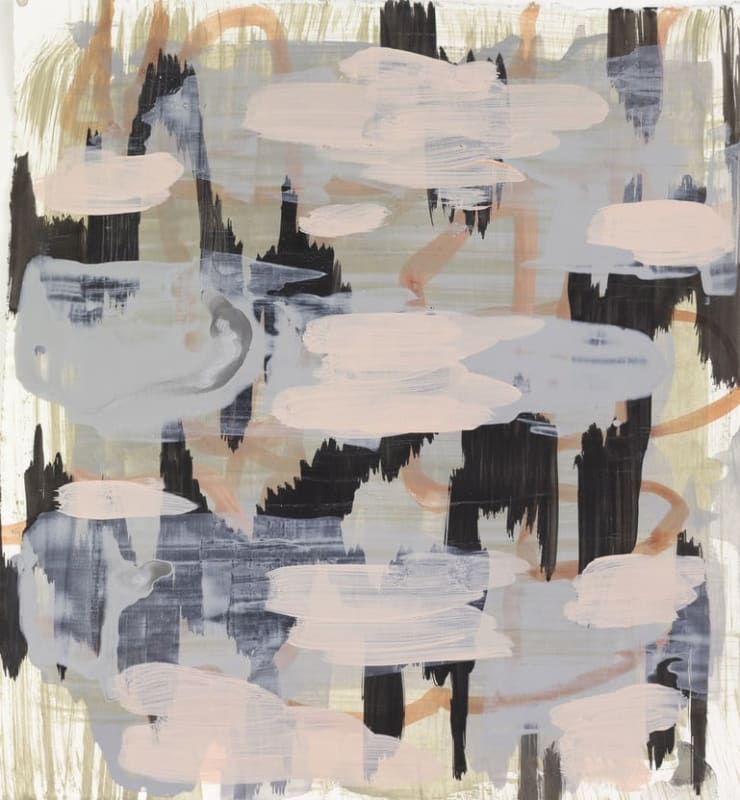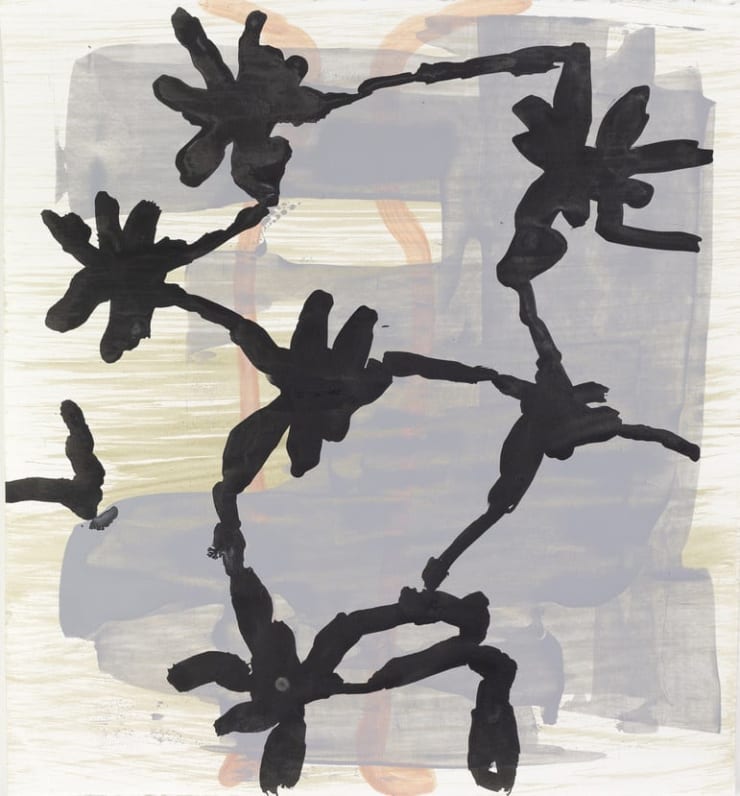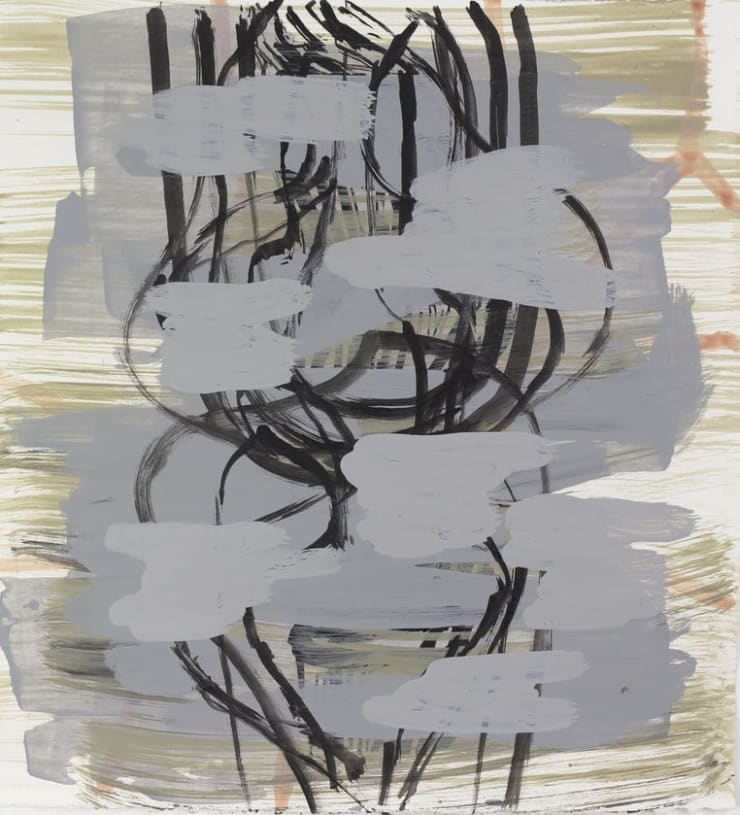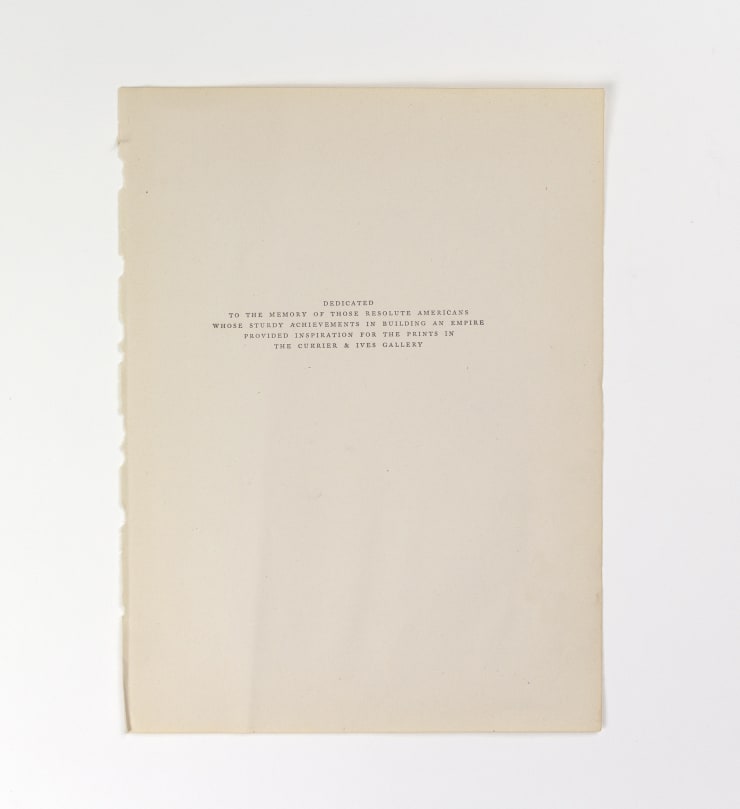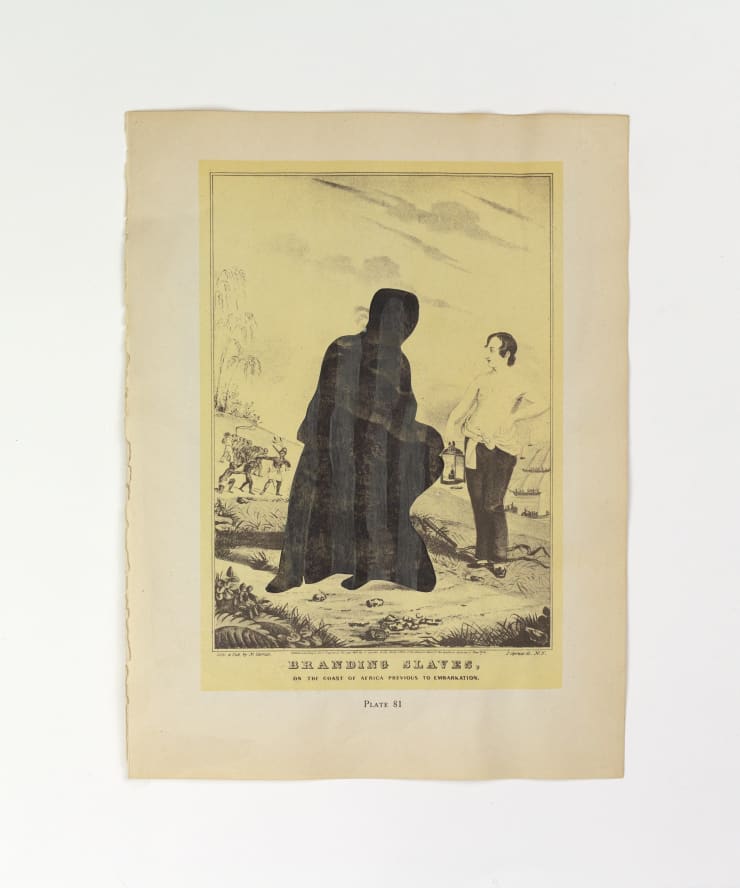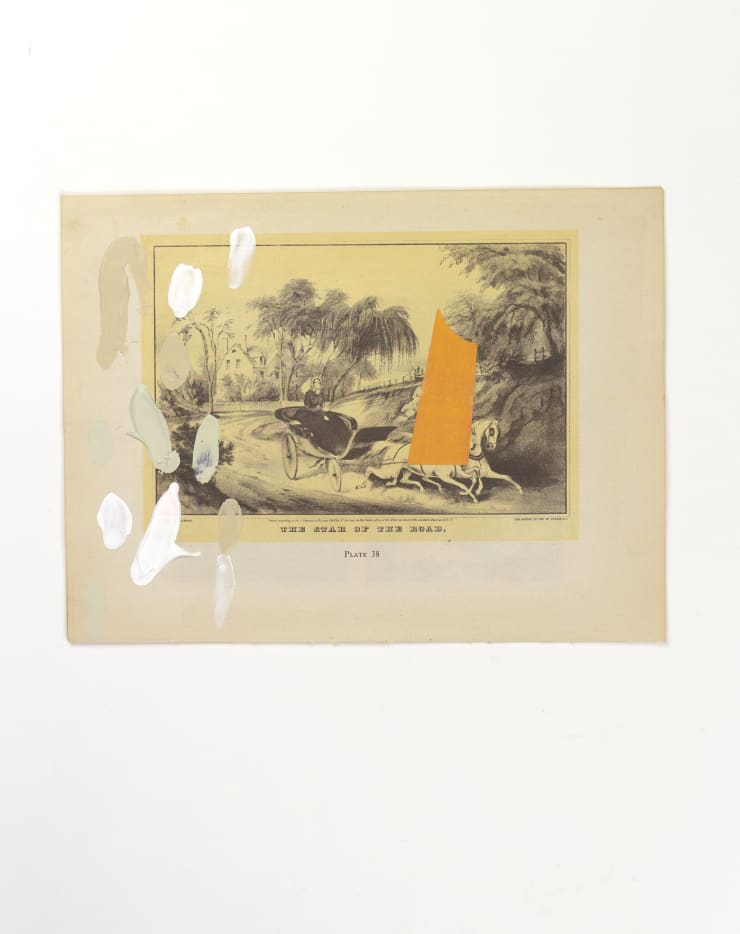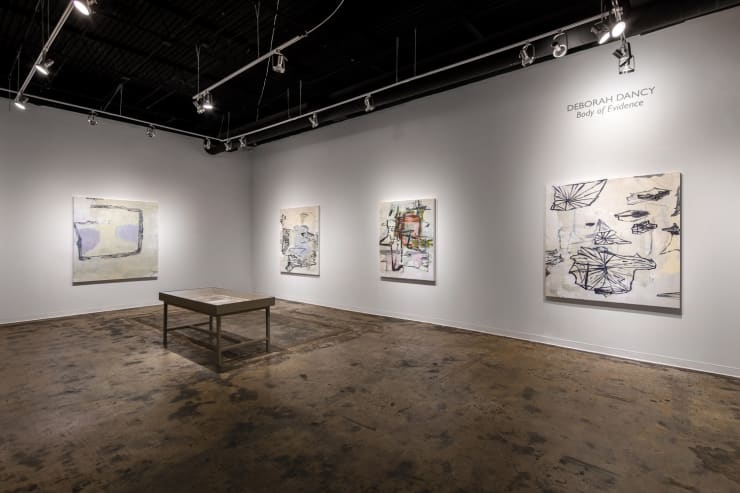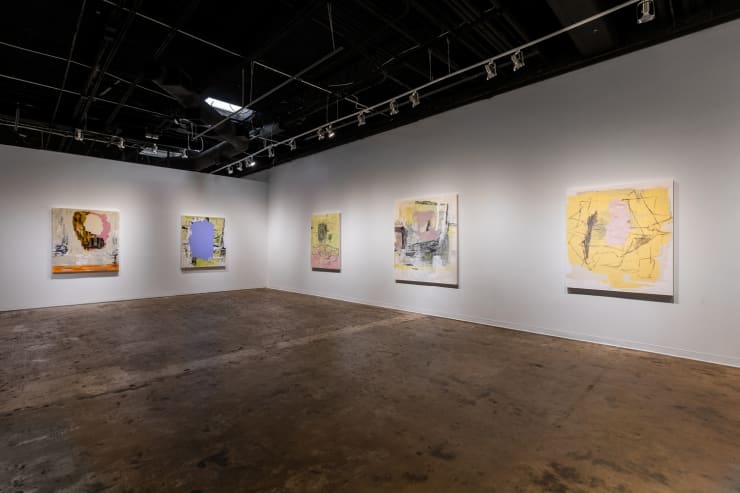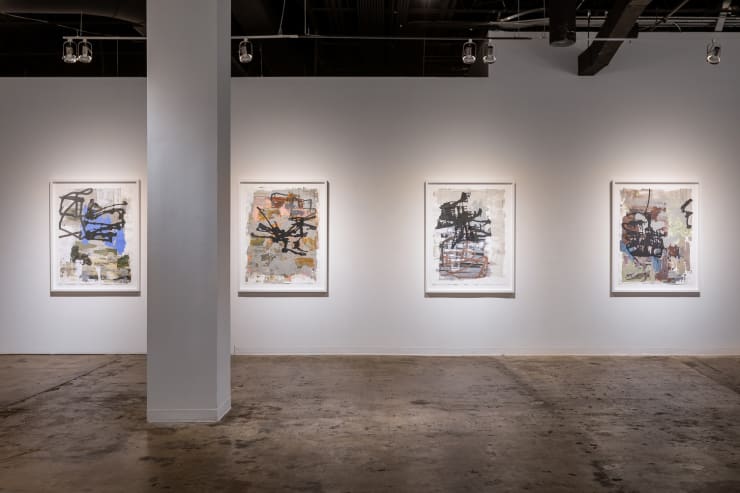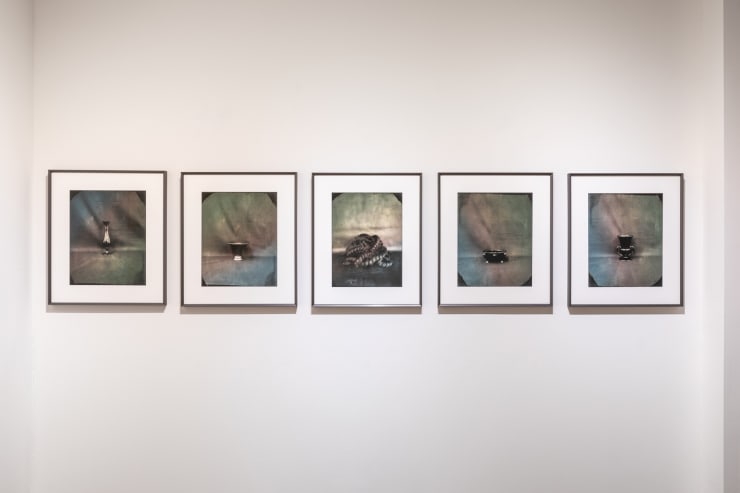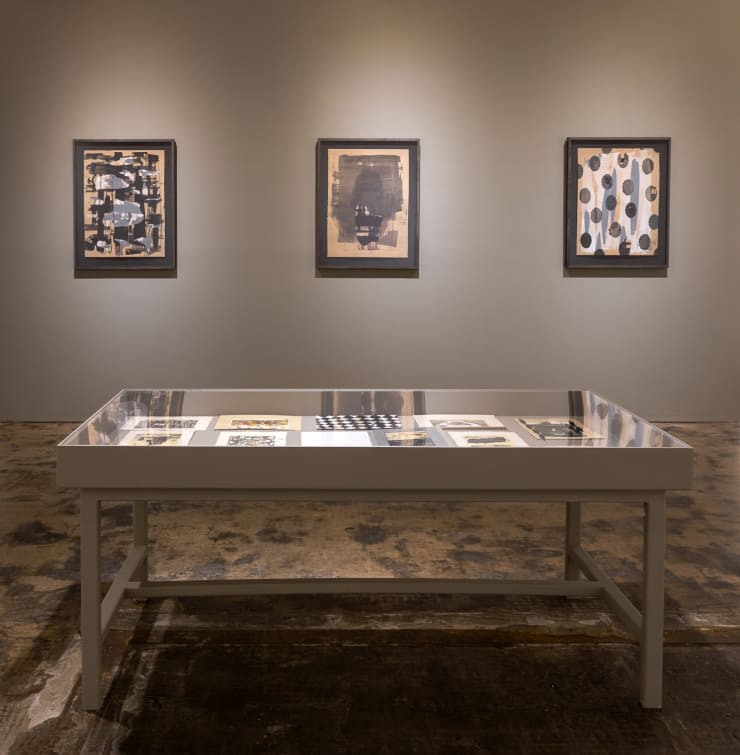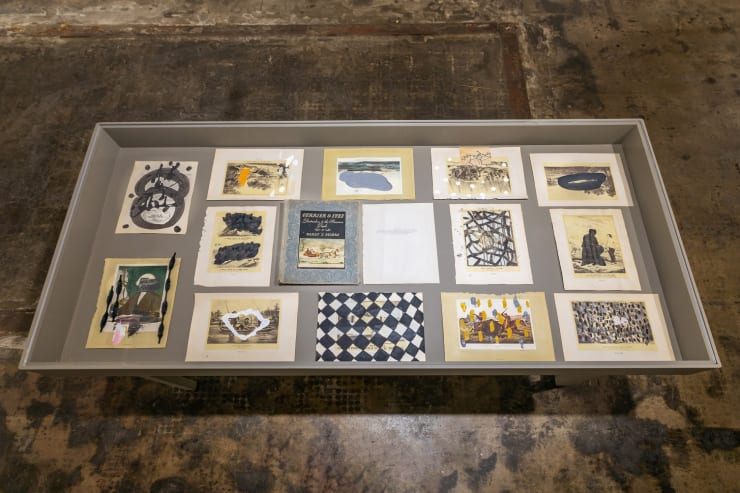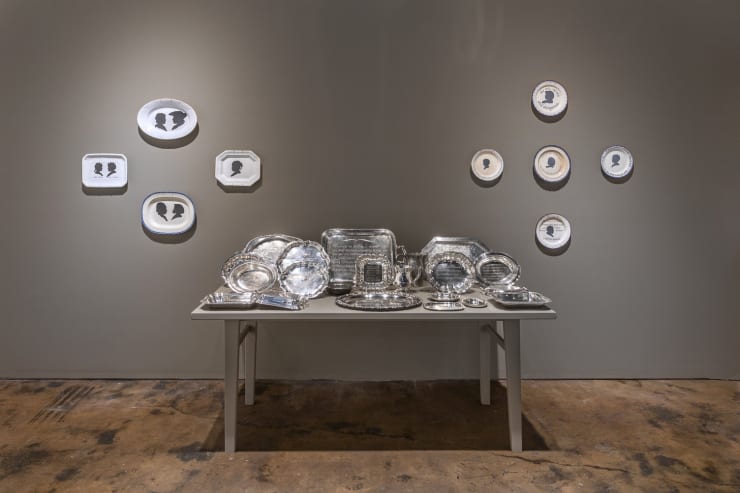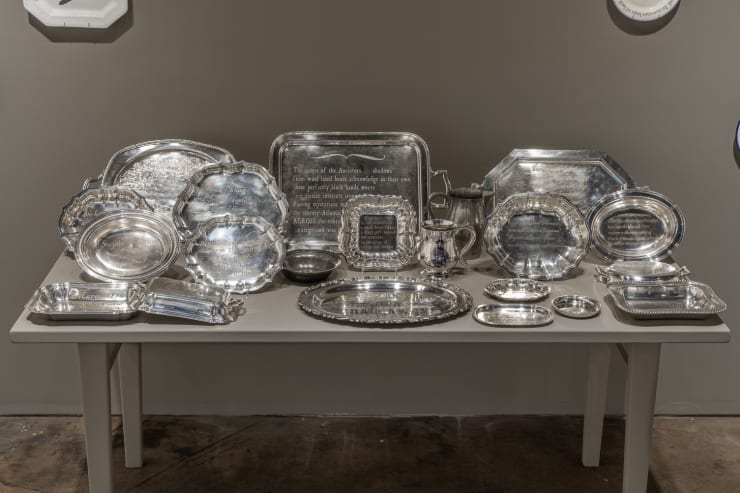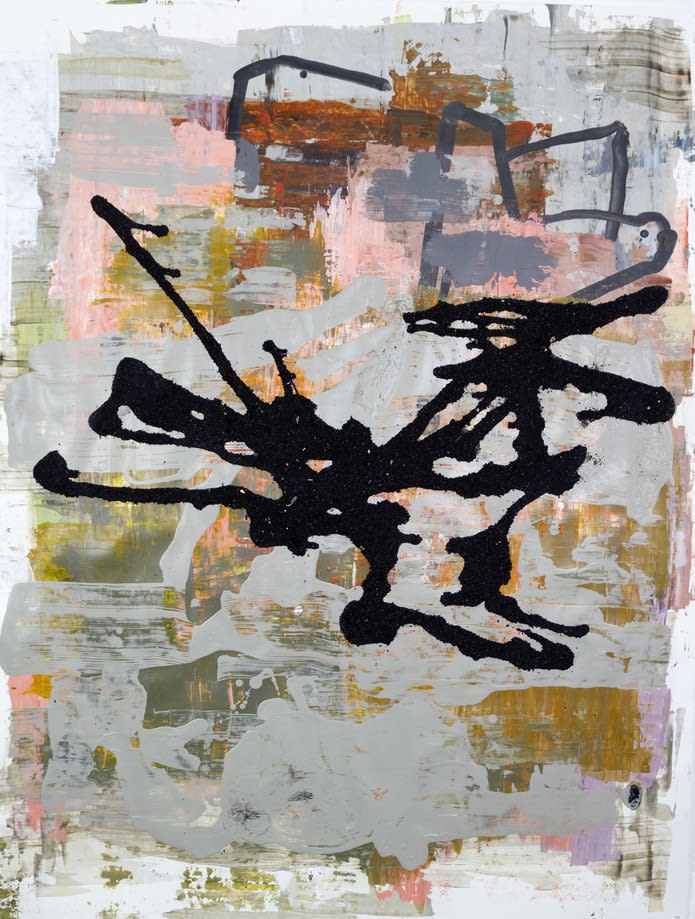Deborah Dancy: Body of Evidence
Bringing together multiple recently created bodies of work, Body of Evidence, Deborah Dancy's second solo show at the gallery, provides a comprehensive survey of Dancy’s explorations in various mediums including painting, sculpture, and photography, which she unites to pursue a trenchant investigation of abstraction, narrative, and the pernicious undercurrents of American history. Alternately lyrical and subversive, Dancy’s works often operate on multiple levels at once, drawing in the viewer with their aesthetic appeal before revealing unexpectedly sharp barbs of critique and confrontation layered underneath.
In the large-scale, abstract oil paintings for which she best known, Dancy is fundamentally concerned with the sensory and formal aspects of fashioning an object-space upon the canvas, implying the presence of some sort of entity rather than that of mere materials. The complex maneuvers Dancy pursues to this end are subtly animated by her distinctive color palette: pastel pinks and blues tempered by smoky grays and blacks, olive greens and golds. These sickly sweet hues seduce the viewer—offering easy suggestions of innocence or virtue—while the darker shades obscure further discernment, confronting the viewer with the dynamics of their own seduction. In this sense, these paintings function as complex visual puzzles that invite the viewer to consider a range of emotional responses to the work, from attraction and intrigue to repulsion and disgust, all while edging toward the sublime.
Often created with acrylic rather than oil paint, Dancy’s works on paper possess a starkly graphic sensibility, implying a speedier, more cavalier process than her large-scale paintings. This relative quickness allows the artist to convey a sense of urgency within these works, which are focused less on internal structure and more on the immediacy of mark-making. More stripped down than her paintings in terms of color and composition, these works on paper indicate Dancy’s training and previous experiences as a printmaker.
A specific series of works on paper included in Body of Evidence is derived from the book Currier & Ives: Printmakers to the American People by Harry T. Peters, first published in 1942. Currier and Ives ran their namesake printmaking firm in New York City from 1835 to 1907, producing archetypal images of the nineteenth century that are still invoked today in the lyrics of Christmas songs and on holiday cards. What is less well known, however, is that the firm’s best-selling series proliferated racist caricatures of African Americans, representing a third of Currier and Ives’s business by 1884. Dancy identified some indication of this disturbing history in the book’s dedication “to the memory of those resolute Americans whose sturdy achievements in building an empire provided inspiration for the prints in the Currier & Ives Gallery.” As a means of disrupting the common rose-colored view of these images and highlighting the imperial impulse they contain, Dancy has applied abstract techniques similar to those in her other works on paper to pages culled from Printmakers to the American People.
Challenges to traditional notions of propriety and class occur repeatedly throughout the exhibition, raising questions about the endurance of such ideologically driven ideals in the forms of nostalgia and kitsch. In the sculptural series Domestic Resistance, for example, Dancy engraves text upon found silver plates and serving trays—“defacing” them, in her own words, tarnishing their supposed purity. The engraved text comes from artist books Dancy previously created: The Practical Speller (1998) and The Conjurer’s Apprentice, or The Legend of Yellow Mary: A Slave Girl's Tale of Survival by her Wit and Extraordinary Powers, as written by herself (2004). These books adopt the narrative structure and typographic design of nineteenth-century chapbooks published by formerly enslaved African Americans, such as Incidents in the Life of a Slave Girl by Harriet Jacobs (1861) and The Narrative of the Life of Frederick Douglass (1845). Accordingly, the text engraved in silver shows fleeting glimpses of stories-in-progress. One reads, “Brought from the West Indies / a small brown girl / nine years young / stood in a room and / wept.” Because of their reflective surfaces, the silver objects in Domestic Resistance also implicate the viewer’s presence within this violent history—another subtle confrontation.
By contrast, the black objects Dancy has documented in the series of photographs included in Body of Evidence are formally opaque, inscrutable despite their reflective surfaces. Primarily showing vessels, bowls, or figurines, these tintype-inspired photographs display a certain classical quality yet also depict these objects in a form of conceptual portraiture. One photograph shows a coil of hair purchased from a beauty supply store wound tightly in a mound, either a monument to Black womanhood or else—as the artist has pointed out—a sinister trophy. This ambiguity, which pervades the entire exhibition, recalls questions asked by artist and writer Kristina Kay Robinson: “Are you an art lover or a voyeur? An observer or a participant? Do the images please you and, if so, is it joy you feel or the pleasure of consumption?”
-
 Deborah DancyBody of Evidence, 2021oil on canvas70 x 64 inches
Deborah DancyBody of Evidence, 2021oil on canvas70 x 64 inches -
 Deborah DancyHistory Lesson, 2021oil on canvas70 x 64 inches
Deborah DancyHistory Lesson, 2021oil on canvas70 x 64 inches -
 Deborah DancyBlind Faith, 2022acrylic on canvas60 x 50 inches
Deborah DancyBlind Faith, 2022acrylic on canvas60 x 50 inches -
 Deborah DancyBoundaries and Borders, 2022acrylic on canvas60 x 50 inches
Deborah DancyBoundaries and Borders, 2022acrylic on canvas60 x 50 inches -
 Deborah Dancy, Catch and Release, 2022
Deborah Dancy, Catch and Release, 2022 -
 Deborah Dancy, Departures, 2022
Deborah Dancy, Departures, 2022 -
 Deborah Dancy, Evidence to the Contrary, 2021
Deborah Dancy, Evidence to the Contrary, 2021 -
 Deborah DancySweet Dreams, 2021acrylic and oil on canvas70 x 64 inches
Deborah DancySweet Dreams, 2021acrylic and oil on canvas70 x 64 inches -
 Deborah DancyReflections, 2021oil on canvas60 x 50 inches
Deborah DancyReflections, 2021oil on canvas60 x 50 inches -
 Deborah Dancy, This is It, 2022
Deborah Dancy, This is It, 2022 -
 Deborah Dancy, Undertow, 2022
Deborah Dancy, Undertow, 2022 -
 Deborah Dancy, The Weight of a Million Black Stars #1, 2019
Deborah Dancy, The Weight of a Million Black Stars #1, 2019 -
 Deborah DancyThe Weight of a Million Black Stars #11, 2020acrylic and black crushed stone on paper50 x 38 inches
Deborah DancyThe Weight of a Million Black Stars #11, 2020acrylic and black crushed stone on paper50 x 38 inches -
 Deborah Dancy, The Weight of a Million Black Stars #7, 2020
Deborah Dancy, The Weight of a Million Black Stars #7, 2020 -
 Deborah Dancy, The Weight of a Million Black Stars #15, 2019
Deborah Dancy, The Weight of a Million Black Stars #15, 2019 -
 Deborah Dancy, The Weight of a Million Black Stars #9, 2020
Deborah Dancy, The Weight of a Million Black Stars #9, 2020 -
 Deborah Dancy, The Weight of a Million Black Stars #3, 2020
Deborah Dancy, The Weight of a Million Black Stars #3, 2020 -
 Deborah DancyClassic Black 14, 2018archival digital printimage size: 20 x 16 inches
Deborah DancyClassic Black 14, 2018archival digital printimage size: 20 x 16 inches
paper size: 25 x 24 inchesedition 1/4 -
 Deborah Dancy, Classic Black 16, 2018
Deborah Dancy, Classic Black 16, 2018 -
 Deborah Dancy, Classic Black 18, 2018
Deborah Dancy, Classic Black 18, 2018 -
 Deborah Dancy, Classic Black, 2018
Deborah Dancy, Classic Black, 2018 -
 Deborah DancyClassic Black 10, 2018Archival digital printimage size: 20 x 15 inches
Deborah DancyClassic Black 10, 2018Archival digital printimage size: 20 x 15 inches
paper size: 25 x 24 inchesedition 1/4 -
 Deborah DancyDomestic Resistance, 2019-2022antique platter, plates, crockery, silver plates, and pewter objects with transfer images and stencil silhouettesdimensions variable
Deborah DancyDomestic Resistance, 2019-2022antique platter, plates, crockery, silver plates, and pewter objects with transfer images and stencil silhouettesdimensions variable -
 Deborah DancyCapable , 2022antique feather edge ironstone plate with stenciled silhouette and text1 x 10 inches
Deborah DancyCapable , 2022antique feather edge ironstone plate with stenciled silhouette and text1 x 10 inches -
 Deborah Dancy, Slender Black Boy, 2022
Deborah Dancy, Slender Black Boy, 2022 -
 Deborah Dancy, Ancestors 2, 2022
Deborah Dancy, Ancestors 2, 2022 -

-
 Deborah Dancy, Black/White, 2019
Deborah Dancy, Black/White, 2019 -
 Deborah Dancy, In The Darkness of A House, 2019
Deborah Dancy, In The Darkness of A House, 2019 -
 Deborah DancyOne Box, 2021text embossed on silver plate8 x 11 inches
Deborah DancyOne Box, 2021text embossed on silver plate8 x 11 inches -
 Deborah DancyVessel Friendship, 2019text embossed on silver plate8.75 x 12 inches
Deborah DancyVessel Friendship, 2019text embossed on silver plate8.75 x 12 inches -
 Deborah Dancy, She Will Jump, 2019
Deborah Dancy, She Will Jump, 2019 -
 Deborah Dancy, Resistance #2, 2021
Deborah Dancy, Resistance #2, 2021 -
 Deborah DancyResistance #13, 2021acrylic on paper30 x 22 inches
Deborah DancyResistance #13, 2021acrylic on paper30 x 22 inches -
 Deborah Dancy, Resistance #17, 2021
Deborah Dancy, Resistance #17, 2021 -
 Deborah Dancy, Cipher 5 , 2021
Deborah Dancy, Cipher 5 , 2021 -
 Deborah DancyCipher 6, 2021acrylic on paper15 x 13.75 inches
Deborah DancyCipher 6, 2021acrylic on paper15 x 13.75 inches -
 Deborah DancyCipher 10, 2021acrylic on paper15 x 13.75 inches
Deborah DancyCipher 10, 2021acrylic on paper15 x 13.75 inches -
 Deborah DancyCipher 20, 2021acrylic on paper15 x 13.75 inches
Deborah DancyCipher 20, 2021acrylic on paper15 x 13.75 inches -
 Deborah DancyCipher 25, 2021acrylic on paper15 x 13.75 inches
Deborah DancyCipher 25, 2021acrylic on paper15 x 13.75 inches -
 Deborah DancyCipher 27, 2021acrylic on paper15 x 13.75 inches
Deborah DancyCipher 27, 2021acrylic on paper15 x 13.75 inches -
 Deborah DancyPreface, 2021The Abridged Currier and Ives altered book, acrylic and glitter11 7/8 x 9 7/8 inches
Deborah DancyPreface, 2021The Abridged Currier and Ives altered book, acrylic and glitter11 7/8 x 9 7/8 inches -
 Deborah DancyThe Abridged Currier and Ives, Branding, 2021The Abridged Currier and Ives altered book, acrylic and cutaway collage11 7/8 x 9 7/8 inches
Deborah DancyThe Abridged Currier and Ives, Branding, 2021The Abridged Currier and Ives altered book, acrylic and cutaway collage11 7/8 x 9 7/8 inches -
 Deborah Dancy, Campfire, 2021
Deborah Dancy, Campfire, 2021 -
 Deborah Dancy, Clipper Nightingale, 2021
Deborah Dancy, Clipper Nightingale, 2021 -
 Deborah DancyThe Abridged Currier and Ives, Colored Engravings for the People, 2021The Abridged Currier and Ives altered book, acrylic and glitter11 7/8 x 9 7/8 inches
Deborah DancyThe Abridged Currier and Ives, Colored Engravings for the People, 2021The Abridged Currier and Ives altered book, acrylic and glitter11 7/8 x 9 7/8 inches -
 Deborah Dancy, Life on the Prairie, 2021
Deborah Dancy, Life on the Prairie, 2021 -
 Deborah Dancy, Low Water in the Mississippi, 2021
Deborah Dancy, Low Water in the Mississippi, 2021 -
 Deborah Dancy, My First Love, 2021
Deborah Dancy, My First Love, 2021 -
 Deborah Dancy, Partridge Shooting, 2021
Deborah Dancy, Partridge Shooting, 2021 -
 Deborah Dancy, Preparing for Market, 2021
Deborah Dancy, Preparing for Market, 2021 -
 Deborah Dancy, The Star of the Road, 2021
Deborah Dancy, The Star of the Road, 2021 -
 Deborah Dancy, Uncle Tom's Cabin, 2021
Deborah Dancy, Uncle Tom's Cabin, 2021
Bringing together multiple recently created bodies of work, Body of Evidence provides a comprehensive survey of Dancy's explorations in various mediums including painting, sculpture, and photography, which she unites to pursue a trenchant investigation of abstraction, narrative, and the pernicious undercurrents of American history. Alternately lyrical and subversive, Dancy's works often operate on multiple levels at once, drawing in the viewer with their aesthetic appeal before revealing unexpectedly sharp barbs of critique and confrontation layered underneath.
In the large-scale, abstract oil paintings for which she best known, Dancy is fundamentally concerned with the sensory and formal aspects of fashioning an object-space upon the canvas, implying the presence of some sort of entity rather than that of mere materials. The complex maneuvers Dancy pursues to this end are subtly animated by her distinctive color palette: pastel pinks and blues tempered by smoky grays and blacks, olive greens and golds. These sickly sweet hues seduce the viewer-offering easy suggestions of innocence or virtue-while the darker shades obscure further discernment, confronting the viewer with the dynamics of their own seduction. In this sense, these paintings function as complex visual puzzles that invite the viewer to consider a range of emotional responses to the work, from attraction and intrigue to repulsion and disgust, all while edging toward the sublime.
Often created with acrylic rather than oil paint, Dancy's works on paper possess a starkly graphic sensibility, implying a speedier, more cavalier process than her large-scale paintings. This relative quickness allows the artist to convey a sense of urgency within these works, which are focused less on internal structure and more on the immediacy of mark-making. More stripped down than her paintings in terms of color and composition, these works on paper indicate Dancy's training and previous experiences as a printmaker.
A specific series of works on paper included in Body of Evidence is derived from the book Currier & Ives: Printmakers to the American People by Harry T. Peters, first published in 1942. Currier and Ives ran their namesake printmaking firm in New York City from 1835 to 1907, producing archetypal images of the nineteenth century that are still invoked today in the lyrics of Christmas songs and on holiday cards. What is less well known, however, is that the firm's best-selling series proliferated racist caricatures of African Americans, representing a third of Currier and Ives's business by 1884. Dancy identified some indication of this disturbing history in the book's dedication "to the memory of those resolute Americans whose sturdy achievements in building an empire provided inspiration for the prints in the Currier & Ives Gallery." As a means of disrupting the common rose-colored view of these images and highlighting the imperial impulse they contain, Dancy has applied abstract techniques similar to those in her other works on paper to pages culled from Printmakers to the American People.
Challenges to traditional notions of propriety and class occur repeatedly throughout the exhibition, raising questions about the endurance of such ideologically driven ideals in the forms of nostalgia and kitsch. In the sculptural series Domestic Resistance, for example, Dancy engraves text upon found silver plates and serving trays-"defacing" them, in her own words, tarnishing their supposed purity. The engraved text comes from artist books Dancy previously created: The Practical Speller (1998) and The Conjurer's Apprentice, or The Legend of Yellow Mary: A Slave Girl's Tale of Survival by her Wit and Extraordinary Powers, as written by herself (2004). These books adopt the narrative structure and typographic design of nineteenth-century chapbooks published by formerly enslaved African Americans, such as Incidents in the Life of a Slave Girl by Harriet Jacobs (1861) and The Narrative of the Life of Frederick Douglass (1845). Accordingly, the text engraved in silver shows fleeting glimpses of stories-in-progress. One reads, "Brought from the West Indies / a small brown girl / nine years young / stood in a room and / wept." Because of their reflective surfaces, the silver objects in Domestic Resistance also implicate the viewer's presence within this violent history-another subtle confrontation.
By contrast, the black objects Dancy has documented in the series of photographs included in Body of Evidence are formally opaque, inscrutable despite their reflective surfaces. Primarily showing vessels, bowls, or figurines, these tintype-inspired photographs display a certain classical quality yet also depict these objects in a form of conceptual portraiture. One photograph shows a coil of hair purchased from a beauty supply store wound tightly in a mound, either a monument to Black womanhood or else-as the artist has pointed out-a sinister trophy. This ambiguity, which pervades the entire exhibition, recalls questions asked by artist and writer Kristina Kay Robinson: "Are you an art lover or a voyeur? An observer or a participant? Do the images please you and, if so, is it joy you feel or the pleasure of consumption?"
